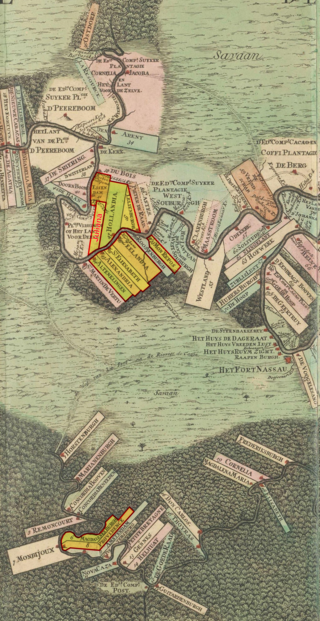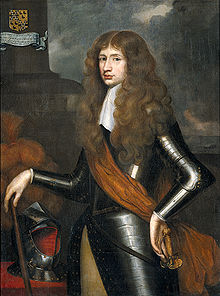The early history of Suriname dates from 3000 BCE when Native Americans first inhabited the area. The Dutch acquired Suriname from the English,and European settlement in any numbers dates from the 17th century,when it was a plantation colony utilizing slavery for sugar cultivation. With abolition in the late 19th century,planters sought labor from China,Madeira,India,and Indonesia,which was also colonized by the Dutch. Dutch is Suriname's official language. Owing to its diverse population,it has also developed a creole language,Sranan Tongo.

Cornelis Lely was a Dutch politician of the Liberal Union and civil engineer. He oversaw the passage of an act of parliament authorising construction of the Zuiderzee Works,a huge project –designed to his own plans –that turned the Zuiderzee into a lake and made possible the conversion of a vast area of former seabed into dry land. Lelystad,the capital of the province of Flevoland,is named after him.

Berbice is a region along the Berbice River in Guyana,which was between 1627 and 1792 a colony of the Dutch West India Company and between 1792 and 1815 a colony of the Dutch state. After having been ceded to the United Kingdom of Great Britain and Ireland in the latter year,it was merged with Demerara-Essequibo to form the colony of British Guiana in 1831. It became a county of British Guiana in 1838 till 1958. In 1966,British Guiana gained independence as Guyana and in 1970 it became a republic as the Co-operative Republic of Guyana.

Sommelsdijk is a village on the island of Goeree-Overflakkee,South Holland,the Netherlands,and part of the municipality of the same name. Sommelsdijk has 7,195 inhabitants which makes it the second largest settlement after Middelharnis on the island.

The Berbice Rebellion was a slave rebellion in Guyana that began on 23 February 1763 and lasted to December,with leaders including Coffij. The first major slave revolt in South America,it is seen as a major event in Guyana's anti-colonial struggles,and when Guyana became a republic in 1970 the state declared 23 February as a day to commemorate the start of the Berbice slave revolt.

Jeronimo,Jeronimy or Hierome Clifford was one of the biggest plantation-owners in Suriname in the late 17th century.

Joan or Johan van Scharphuysen,Scharphuizen or Jan van Scherpenhuizen was a Dutch colonist,a judge in Suriname,a slave-trader,colonial governor from 1689 to 1696 on behalf of the Society of Surinam,and a considerable plantation-owner.

The Society of Suriname was a Dutch private company,modelled on the ideas of Jean-Baptiste Colbert and set up on 21 May 1683 to profit from the management and defense of the Dutch Republic's colony of Suriname. It had three participants,with equal shares in the costs and benefits of the society;the city of Amsterdam,the family Van Aerssen van Sommelsdijck,and the Dutch West India Company. Only through mutual consent could these shareholders withdraw from the society.

The Cassard expedition was a sea voyage by French Navy captain Jacques Cassard in 1712,during the War of the Spanish Succession. Targeting English,Dutch,and Portuguese possessions,he raided and ransomed the colonies of Cape Verde,Sint Eustatius,and Curaçao—factories,depots,and seasoning camps used in the Atlantic slave trade. He also raided and ransomed Montserrat,Antigua,Surinam,Berbice,and Essequibo—wealthy sugar-producing colonies in the Caribbean whose economies were based on the exploitation of slave labor.

Surinam,also unofficially known as Dutch Guiana,was a Dutch plantation colony in the Guianas and the predecessor polity of modern country of Suriname. It was bordered by the fellow Dutch colony of Berbice to the west,and the French colony of Cayenne to the east. It later bordered British Guiana from 1831 to 1966.
Cornelis van Aersens may refer to:

Garden of Palms or Palmgardens is a palm tree landscape garden in Paramaribo,Suriname. In addition to tall royal palms,the grounds are home to tropical birds and a "troop" of capuchin monkeys. Palmentuin is located on Van Roseveltkade behind the Presidential Palace of Suriname and is a tourist attraction.

Fort Nieuw-Amsterdam is a fort in Suriname built from 1734 to 1747 at the confluence of the Suriname and Commewijne rivers. It is open to the public as an open-air museum.
Adjua Gyapiaba,also known as Ajua Japiaba,Api-jaba and Afi Jaba,was a woman from Elmina in contemporary Ghana,who after a heated argument with a fellow Elminan was expelled by the Dutch colonial authorities to Suriname,where she eventually acquired fame as a herbalist and diviner.
Surinamese nationality law is regulated by the 1987 Constitution,the Allocation Agreement of 1975,and the 2014 Surinamese Nationality Law. It is highly influenced by Dutch law. These statutes determine who is,or is eligible to be,a citizen of Suriname. The legal means to acquire nationality,formal membership in a nation,differ from the relationship of rights and obligations between a national and the nation,known as citizenship. Surinamese nationality is typically obtained either under the rules of jus sanguinis,i.e. birth to at least one parent with Surinamese nationality;or on the principle of jus soli,i.e. by birth in Suriname. It can also be granted to a permanent resident who has lived in Suriname for a given period of time or by presidential decree through naturalization.

The Waterkant is the oldest and one of the most important streets of Paramaribo,Suriname. The street is located in the historic centre on the Suriname River,and was the location where ships used to arrive. The street starts at the Onafhankelijkheidsplein and extends to the Central Market. As of 2002,it has been designated a Unesco World Heritage Site.

Jurriaan François de Friderici was a Dutch military officer and plantation owner. He served as Governor of Suriname from 1790 until 1802. In the 1770s,he was involved in the Boni Wars. In 1799,Suriname was conquered by Great-Britain,however de Friderici changed allegiance and remained governor. He was dismissed in 1802 when the colony was returned to the Batavian Republic.

Fort Sommelsdijk was a fort in Suriname built in 1686 at the confluence of the Commewijne and Cottica rivers. Later it was used as a mission post and hospital. In 1870,it lost its function and was only used a military outpost. In the 21st century,the fort was taken over by nature.
Anna van Aerssen van Sommelsdijk and her sisters are particularly known for joining Jean de Labadie and the house congregation of the Labadists in 1669,offering them housing and setting up a community in Wieuwerd in Friesland in 1675.













